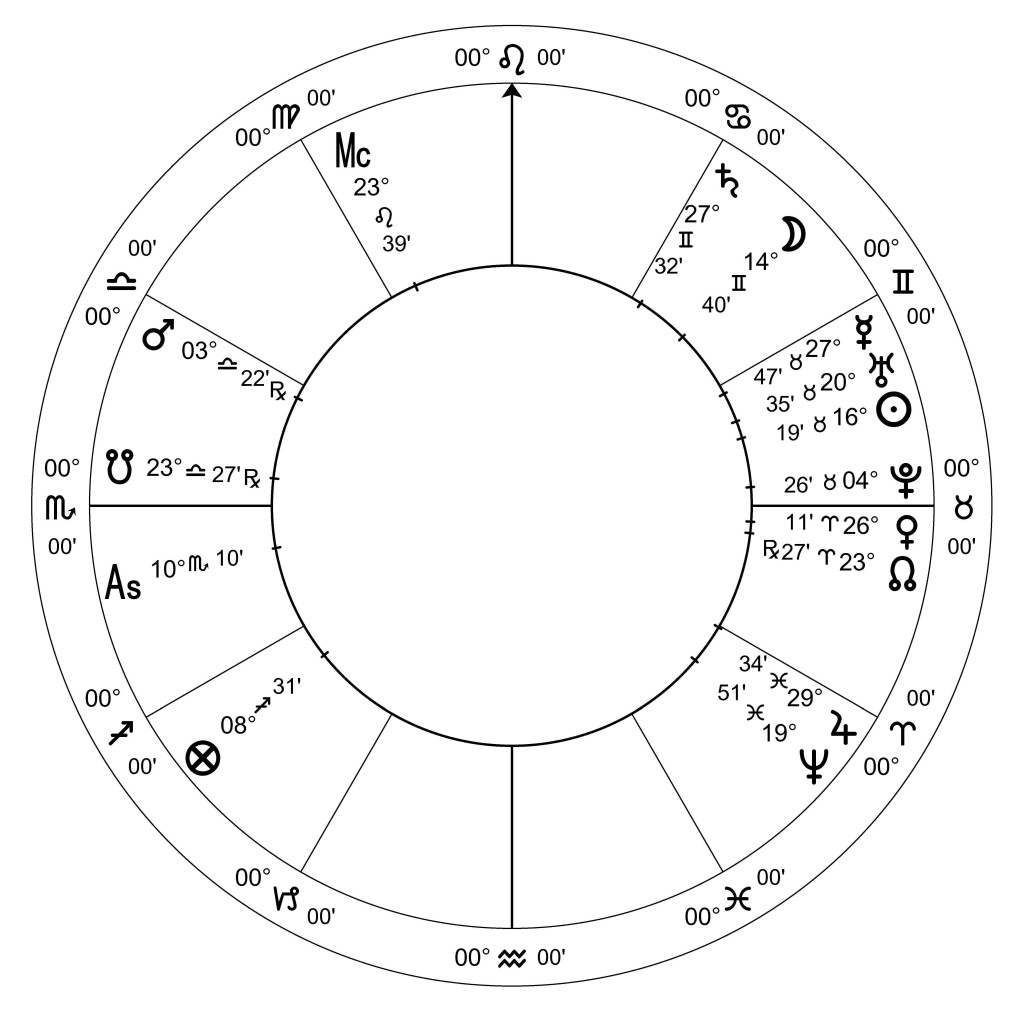This post is about the traditional astrology concept of aversion, and how it plays out in interpreting a chart. I used this example in the webinar I did for Kepler on October 24 of this year, and it intrigued me enough that I want to study it a bit more closely here.
In traditional astrology aspects are primarily by whole sign, and the only aspects that are used are the classical Ptolemaic aspects – sextile, square, trine, opposition.
Signs that are not in a classical aspect with each other – either 30 degrees or 150 degrees – are said to be in aversion, meaning they are turned away from each other, out of the line of vision and hence out of contact.
Aversion as an interpretive concept can play out in some interesting and significant ways, and here we are going to look at the chart of the founder of psychoanalysis, Sigmund Freud.
This is Freud’s chart here – the birth data is, May 6 1856, 6:30 pm, Pribor, Czech Republic. The chart uses whole sign houses.

In this chart, note that the Moon is in Gemini in the eighth house, a house that is averse the ascedant and hence out of awareness. In addition, the Moon is ruled by Mercury, who is in Taurus in the seventh, so the Moon’s ruler is averse to the Moon. The Moon, and everything is stands for, is doubly hidden, doubly averse, doubly out of awareness.
In Freud’s system, I think we can take the Moon in the eighth house as representing the unconscious mind. The unconscious is the averse part of the mind, turned away in awareness from the conscious mind, and there is no direct vision or communication between them. In his system the unconscious is reached by words, by talking (Gemini), and the connection from its seventh house Mercury ruler is averse – in other words, the communication is indirect.
So Freud’s chart, and his system, mirror a split in the psyche where the conscious and unconscious minds are averse, turned away from each other. Freud is looking for a connection, but it can’t be made directly.
As we said, the eighth house has associations with unconscious mind, with the realm of the dead, with the occult, whatever is hidden.
In the chart symbolism here, Mercury in the seventh house is the Freudian analyst sitting and talking one on one with a client. He is being very Taurean and taciturn, letting the analysand speak. It is also interesting that in classical psychoanalysis the Freudian analyst literally sits averse, facing away from the client.
There is a nice tight trine of Mercury to Jupiter and Neptune, both in rulership in Pisces and loosely conjunct. That symbolism nicely shows the receptivity to the content of dreams and their symbolism, but with the Moon being averse there is a lack of a direct emotional attachment – Freud’s Mercury sits averse his Moon, so he analyzes dreams indirectly rather than feeling emotions directly.
There is another striking place in this chart where aversion plays into the meaning of Freud’s system. The Ascendant/ Descendant axis is Scorpio/ Taurus, and the 2 rulers, Mars (Libra in the 12th) and Venus (Aries in the 6th), are both in detriment, and are also in houses averse the angles they rule. Mars and Venus, the male and female sexual planets averse and in opposition to each other, the averse or hidden symbolic sexual element that has such a big emphasis in the Freudian unconscious mind.
So that simple concept of aversion colors much of the meaning of Freud’s chart, and of the system of psycholanalysis that he founded.

Well written, Charles, with lots of insight into Freud and a helpful example for continuing clarity about aversion. [Part of my issue is getting over the word “aversion” itself! Apparently I have an aversion to it!] Thanks for exploring this further and sharing.
This is extremely interesting. I have not use averison in my chart work, but will from now on, as I see its importance. I heard your webiner for Kelper and found it very informative.
Thank you,
Lindy
Rebecca, you illustrate an interesting point here – the word ‘aversion’ in modern English means something different. If you have an aversion for something it is repelling you. That is not the same as saying it is out of your line of vision, which is the meaning of the technical term in traditional astrology. You used the term in the modern sense rather than the technical astrology sense. I’ll bet the modern connotation is part of why you have an aversion to the word.
Truly! I do understand. So, when a house & planets in it are not in view, they could be considered part of one’s unconscious, not unlike your suggestion of Freud’s Moon. I am still not clear how those planets participate actively. Perhaps as we become more aware as we age, their role becomes clearer and clearer.
Hi Charlie, excellent analysis! I wonder if someday you’ll do Jung’s horoscope with an eye toward revealing why Jung was intensely connected to the unconscious and to the emotional life of dreams and archetypes. The value in a side by side of these two giants would be another layer of instruction as to why Jung broke away from “Father” Freud.
I like your suggestion to examine Jung’s horoscope, and also look at Jung and Freud together. Great idea; I will spend some time on that,